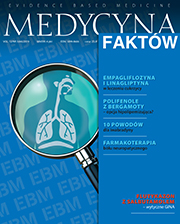10 reasons why it is worth to use ivabradine Review article
Main Article Content
Abstract
Ivabradine is a unique, modern drug whose mechanism of action consists in blocking the If current in the sinoatrial node. This translates into a reduction in heart rate – a parameter associated with an unfavorable prognosis in patients with heart failure. Nowadays, it is a different group of patients than it was encountered in clinical practice a few years ago. Due to different demographic structure and other health needs, methods of pharmacological treatment also need to be constantly modified. Ivabradine is a drug that responds to the needs of the modern patient – ensures not only the reduction of mortality, but also has a positive effect on such factors as the risk of repeated hospitalization, haemodynamic parameters, exercise capacity and quality of life.
Article Details
Copyright © by Medical Education. All rights reserved.
References
2. Fox K., Ford I., Steg P.G. et al.: BEAUTIFUL investigators. Heart rate as a prognostic risk factor in patients with coronary artery disease and left-ventricular systolic dysfunction (BEAUTIFUL): a subgroup analysis of a randomised controlled trial. Lancet 2008; 372(9641): 817-821.
3. Messerli F.H., Bangalore S., Grossman E.: Adverse effects and tolerability of β blockers. B.M.J. 2016; 353: i3142.
4. Rywik T.M., Kołodziej P., Targoński R. et al.: Characteristics of the heart failure population in Poland: ZOPAN, a multicentre national programme. Kardiol. Pol. 2011; 69(1): 24-31.
5. Fonarow G.C., Abraham W.T., Albert N.M. et al.: Dosing of beta-blocker therapy before, during, and after hospitalization for heart failure (from Organized Program to Initiate Lifesaving Treatment in Hospitalized Patients with Heart Failure). Am. J. Cardiol. 2008; 102(11): 1524-1529.
6. Opolski G., Ozierański K., Lelonek M. et al.: Adherence to the guidelines on the management of systolic heart failure in ambulatory care in Poland. Data from the international QUALIFY survey. Pol. Arch. Intern. Med. 2017; 127(10): 657-665.
7. DiFrancesco D., Camm J.A.: Heart rate lowering by specific and selective I(f) current inhibition with ivabradine: a new therapeutic perspective in cardiovascular disease. Drugs 2004; 64(16): 1757-1765.
8. Accili E.A., Proenza C., Baruscotti M. et al.: From funny current to HCN channels: 20 years of excitation. News Physiol. Sci. 2002; 17: 32-37.
9. Bucchi A., Baruscotti M., DiFrancesco D.: Current-dependent block of rabbit sino-atrial node I(f) channels by ivabradine. J. Gen. Physiol. 2002; 120(1): 1-13.
10. Charakterystyka produktu leczniczego Ivabradine Aurovitas 5 mg; 7,5 mg, tabletki powlekane.
11. Kasprzak J.D., Stępińska J., Wożakowska-Kapłon B. et al.: Optymalna częstość rytmu serca – aktualny cel terapii kardiologicznej. Stanowisko grupy ekspertów Sekcji Farmakoterapii Sercowo-Naczyniowej Polskiego Towarzystwa Kardiologicznego. Kardiol. Pol. 2012; 70(10): 1081-1094.
12. Simon L., Ghaleh B., Puybasset L. et al.: Coronary and hemodynamic effects of S 16257, a new bradycardic agent, in resting and exercising conscious dogs. J. Pharmacol. Exp. Ther. 1995; 275(2): 659-666.
13. Colin P., Ghaleh B., Hittinger L. et al.: Differential effects of heart rate reduction and beta-blockade on left ventricular relaxation during exercise. Am. J. Physiol. Heart Circ. Physiol. 2002; 282(2): H672-H679.
14. Berdeaux A.: Preclinical results with I(f) current inhibition by ivabradine. Drugs 2007; 67(Suppl. 2): 25-33.
15. Ponikowski P., Voors A., Anker S. et al.: Wytyczne ESC dotyczące diagnostyki i leczenia ostrej i przewlekłej niewydolności serca w 2016 roku. Kardiol. Pol. 2016; 74(10): 1037-1147.
16. Swedberg K., Komajda M., Böhm M. et al.; SHIFT Investigators: Ivabradine and outcomes in chronic heart failure (SHIFT): a randomised placebo- controlled study. Lancet 2010; 376(9744): 875-885.

